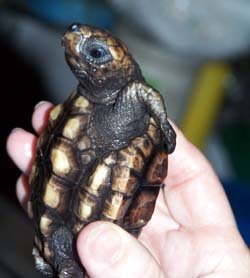Topsail Island Loggerheads
 >
>A special aspect of Topsail Island is the opportunity of observing the hatching of sea turtles. This turtle nest is being protected until the mass hatching occurs. On the Monday that we were on Topsail, a loggerhead nest with 139 eggs hatched. While we did not see the actual “march to the sea”, we were at the nest when Topsail Turtle Project volunteers conducted a nest analysis a couple of days after the hatching. On Wednesday evening, we watched as the volunteers counted the eggs that hatched, those that were not fertile, and helped those young turtles that were still working their way out of the nest to survive. There were four small loggerheads still in the nest and they were allowed to travel to the ocean.>
><
Currently six of the seven species of sea turtles are listed as threatened or endangered. Although the most common species in North Carolina is the loggerhead, five sea turtle species regularly visit North Carolina waters: the loggerhead, Kemp’s ridley, leatherback. Green, and hawksbill. Loggerhead, green turtles, and the massive leatherbacks lay their eggs on North Carolina beaches.
The Topsail Turtle Project locates and monitors young loggerhead turtles until they can make their way out to sea, while the Karen Beasley Sea Turtle Hospital cares for and rehabilitates injured sea turtles until they are healthy enough to return to the ocean. The Karen Beasley Sea Turtle Hospital website is http://www.seaturtlehospital.org/
>
It is normal to have a varying number of nests each year. Female loggerheads come ashore to nest 3 to 5 times during a nesting year. Each time she deposits an average of 120 eggs; known as a clutch. The eggs will incubate for about 60 days.
When it is hatching time, the baby turtles will emerge together and race to the sea. They have many obstacles to contend with. Weighing in at about two ounces, they must outrun the ghost crabs, shore birds, and wild and domestic animals looking for an easy snack.

Once in the water they must hide from predators such as birds and fish. It is estimated that only one in 1,000 survives the first year and only one in 10,000 survives to adulthood. At that time the females will return to the beaches where they were hatched to lay their eggs. The cycle then begins once again.>
As tough as turtles might look with their armor like shells, they can actually be quite vulnerable to injuries. Cold snaps, sharks and run-ins with boats and fishing nets are just some of the hazards that sea turtles face.
That is where the sea turtle hospital comes in. At the hospital, volunteers nurse back to health any turtles that may be ill or injured. The website has photos of current patients that are being treated at the hospital.




0 Comments:
Post a Comment
<< Home